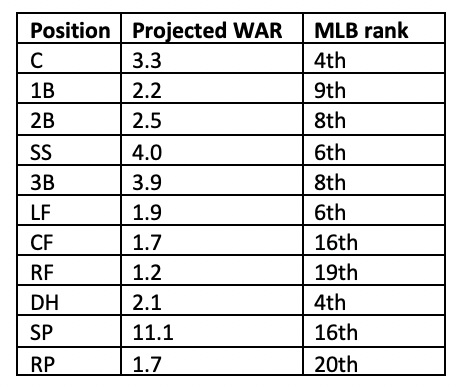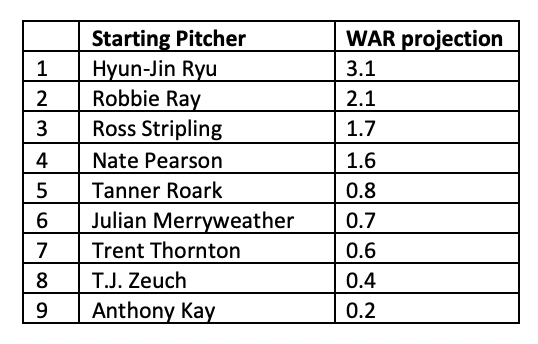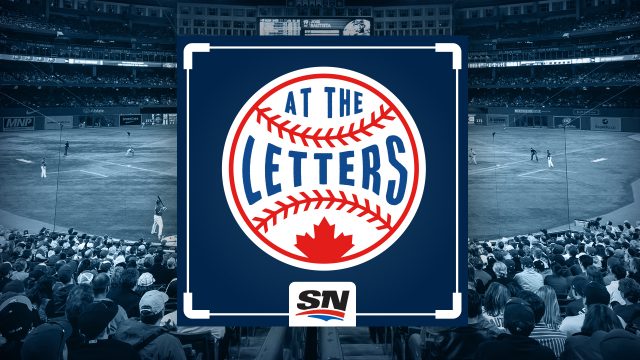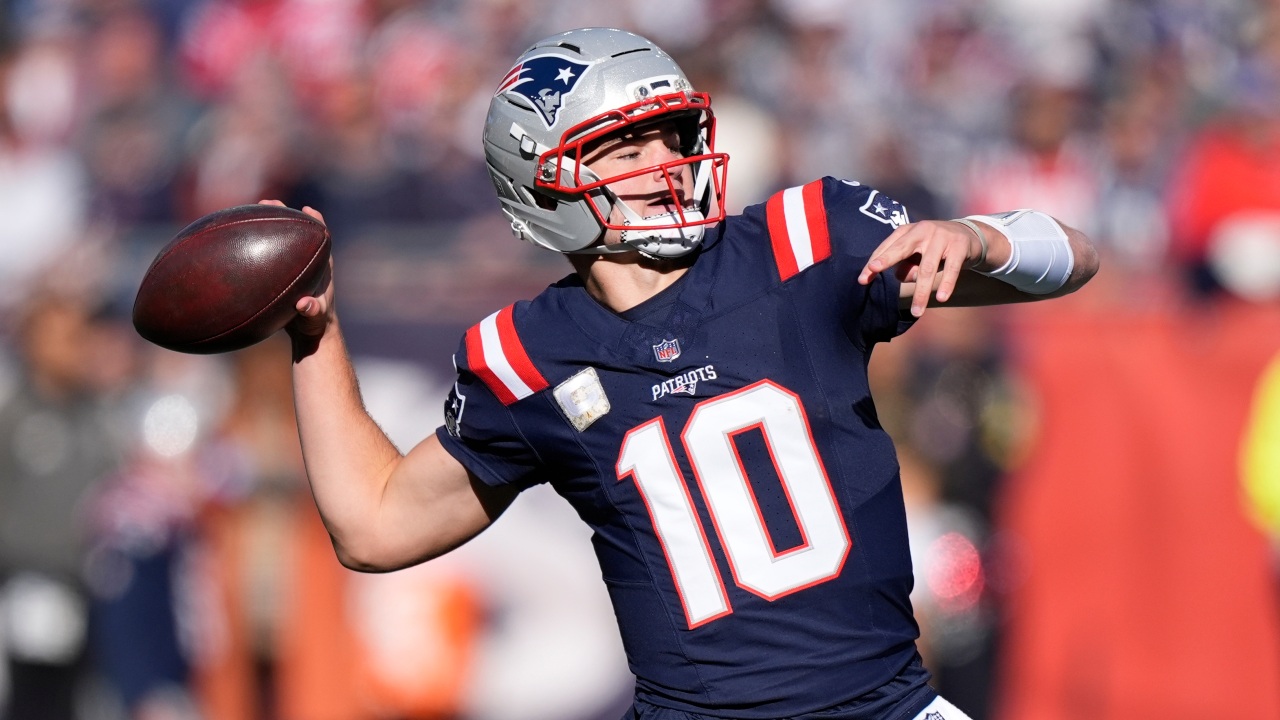
As a function of this winter’s most impactful free agents being almost exclusively position players — J.T. Realmuto, George Springer, DJ LeMahieu, etc. — the discourse and speculation around what the Toronto Blue Jays might do to continue improving their team after an unexpected 2020 playoff appearance has centred on, well, position players.
And that’s fine. If you have currency and playing time to offer, go get the best talent available. This winter, much of that best talent produces runs. But maybe market realities are causing us to overlook a more dire need for this club that its front office will have to find a way to address if 2021 is going to represent another significant step forward: preventing them.
Here’s where the Blue Jays rank in projected WAR at each position as things stand today (per FanGraphs’s depth charts feature, which blends ZiPS and Steamer projections before scaling based on expected playing time):

Now, the usual caveats apply. Projections like these are not gospel, as it’s very difficult to reliably predict human performance in a game prone to the whims of luck and variance such as baseball. They will be right on some players and wrong on others. These forecasts are only as good as the information currently available to build them on — and sometimes that information is flawed.
Projections can also change as more information becomes available. For instance, FanGraphs currently projects the majority of Vladimir Guerrero Jr.’s 2021 playing time to come at third base, which remains unlikely despite his return to the position this offseason during winter ball play. Replace his 3.3 fWAR projection at third with some combination of Cavan Biggio and Santiago Espinal, and the Blue Jays drop toward the bottom of the league in terms of expected production.
Also, if just about any team below the Blue Jays in those third base rankings were to sign Justin Turner, who’s projected to be worth 3 fWAR in 2021, they’d bump Toronto further down the list and make the position look like more of a need than it presently does. Same goes for any club that was to sign Realmuto (3.7 fWAR), LeMahieu (3), Springer (2.8), etc. at their respective positions.
All that said, it’s pretty clear looking at these projections why the Blue Jays have had such strong interest in Springer. Not that you needed anything more than the eye test to tell you this, but the club could use an outfield upgrade. Its currently projected for the 16th-most WAR in centre field and the 19th-most in right. Even if you’re buying Teoscar Hernandez’s breakout — which projection systems aren’t, for what it’s worth, based on 2020’s small sample nature and the much-larger and much-less-impressive body of work he produced prior — the Blue Jays are still toward the bottom half of the league in expected centre field production.
But matters are even worse when it comes to pitching. Add up the run production categories and the Blue Jays rank seventh among all teams, positioning Toronto’s emerging hitters well to follow up 2020’s top-10 offence. Add up the run prevention projections, however, and the Blue Jays sit 19th. And they’re a Hyun-Jin Ryu injury away from being much lower than that.
2021 AL East FanGraphs WAR projections (MLB rank in brackets)

This isn’t to say the Blue Jays shouldn’t have made attempts to acquire Francisco Lindor and Ha-seong Kim. It isn’t to say they shouldn’t continue to aggressively pursue Springer and LeMahieu. But it is to say that perhaps the highest leverage improvement the Blue Jays can make this winter isn’t adding a premium position player to what is projected to be one of the AL East’s better offences — it’s adding quality arms to what is projected to be one of its lesser pitching staffs.
As things currently stand, here are Toronto’s starting pitching options in order of their FanGraphs projections:

That’s unlikely to be good enough to contend. It isn’t even better than the Boston Red Sox, last year’s fifth-place AL East finishers, who have three pitchers projected for more fWAR than any non-Ryu Blue Jays — Eduardo Rodriguez (2.3), Nate Eovaldi (2.8), and Chris Sale (3.0), who could return from Tommy John surgery early in the season.
Toronto’s bullpen is similarly underwhelming, with only five pitchers projected to post positive fWAR, two of whom (Thomas Hatch and Patrick Murphy) are likely to begin the season as triple-A starters:

Barring an internal breakout, it appears the Blue Jays will need to add at least one impact starter and multiple quality relievers ahead of the season if they hope to take a meaningful step forward in 2021. And, ideally, those additions would come near the top of these projection charts with proven above-average arms rather than towards the bottom with league-average depth options or bounce-back bets.
Problem is, this winter isn’t a great one for acquiring pitching. Beyond Trevor Bauer, the free agent starter market is rife with uncertainty. It’s not even clear who the next best option would be.
There’s Masahiro Tanaka, the soft-tossing, pitch-mixing craftsman whose elbow has ostensibly been within seconds of self-destruction for a half-dozen years. But that the Yankees declined to extend the 32-year-old a qualifying offer, which would have represented a $4-million decrease on his 2020 non-prorated salary, is perhaps telling.
There’s Corey Kluber, the two-time Cy Young winner who emerged from two seasons lost in the injury wilderness to hold a showcase for MLB clubs on Wednesday. The right-hander’s track record is undeniable, but, as he approaches his 35th birthday, there’s little assurance he still possesses something close to the ability that allowed him to annually contend for ERA titles years ago.
There’s James Paxton, the overpowering-when-healthy Canadian. But his 2020 began with back surgery, progressed to five so-so starts in which his fastball velocity was down three ticks from 2019, and finished with a flexor strain in his pitching arm — facts that do little to assuage concerns over the 32-year-old’s durability. There’s Jake Odorizzi, who profiles similarly to Paxton as a north-of-30 starter with swing-and-miss stuff who barely pitched in 2020 due to multiple injuries, but differs in that he at least maintained his velocity in a handful of outings.
There’s Taijuan Walker, a serviceable mid-to-back-end rotation piece whose strong 2020 results accompanied uninspiring peripherals — including but not limited to well below-average whiff rates, spin rates, and velocity — which may be one reason no team has jumped to sign the young-for-this-class 28-year-old. There’s Matt Shoemaker, Garrett Richards, and JA Happ, who over the last two seasons have all been effective at times — at others, ineffective, injured, or both.
Considering the lack of depth in this class, it’s clear why there was an early-winter run on down-market starting pitching, with Robbie Ray, Drew Smyly, Charlie Morton and Mike Minor all signing before December, while Marcus Stroman and Kevin Gausman accepted their qualifying offers. If a team really liked a particular arm for one reason or another, they moved quickly to snatch him up.
Meanwhile, the international market has dried up. Kohei Arihara landed with the Texas Rangers while Tomoyuki Sugano opted to return to Japan after failing to find a deal he liked with an MLB club, the Blue Jays being among his bidders.
If the Blue Jays don’t land Bauer, who they’ve had recent discussions with, there isn’t another high ceiling rotation option available in free agency. That kind of addition would have to come via trade — but several upper-tier options available in that market have already been moved. The Chicago White Sox landed underrated workhorse Lance Lynn. The San Diego Padres grabbed both Blake Snell and Yu Darvish, who’s had the Blue Jays on his no-trade list in the past. The New York Mets acquired Carlos Carrasco along with Lindor.
So, what’s left? The Cincinnati Reds appear motivated to reduce payroll, which could make Sonny Gray and the $20 million he’s owed over the next two seasons available. It’s possible the same could go for Luis Castillo, who may be looking at around a $4-million 2021 salary in his first year of arbitration eligibility. Castillo’s age, upside, and affordable salary would make him a much costlier pick-up in comparison to Gray, although perhaps the Blue Jays could reduce that acquisition cost by also taking on Mike Moustakas (who Toronto had discussions with last winter) and the $52 million remaining on the four-year contract he signed with Cincinnati ahead of the 2020 season.
Another player the Blue Jays have pursued in the past is Joe Musgrove, the Pittsburgh Pirates right-hander who’s due around a $4-million salary this season in his second year of arbitration eligibility. Those discussions could easily be revisited. Meanwhile, Jon Gray is entering his final year prior to free agency and could come at a relative bargain from the aimless Colorado Rockies after his hard-luck, injury-shortened 2020. And if the Chicago Cubs were willing to deal Yu Darvish to get out from under his salary, would they consider the same with Kyle Hendricks and the $42-million he’s owed over the next three seasons?
The good news is the free agent relief market is typically deep, with veteran options like Brad Hand, Trevor Rosenthal, Alex Colome, and Kirby Yates, who would instantly improve a thin Blue Jays bullpen without chewing up significant payroll. Toronto’s front office has proven adept at unearthing undervalued talent in that market over recent seasons, and its coaching staff has shown an ability to help those players fulfill their potential. They’ll have to continue that trend into 2021 as internal options the Blue Jays relied upon as relievers in 2020 — Hatch, Anthony Kay, Julian Merrryweather — transition back to the rotation roles they were meant to be filling that year in triple-A.
That should place Toronto’s current sights squarely on starting pitching, a position at which the Blue Jays have been a bottom-10 MLB team in terms of WAR produced for three years running. Unideal market realities or not, Toronto ought to be aggressive with any and all opportunities available to upgrade its rotation. Because while Springer or LeMahieu would help an already-potent offence produce more runs, it’s unlikely the Blue Jays will take a significant step forward in 2021 if they don’t find a way to get better at preventing them.






